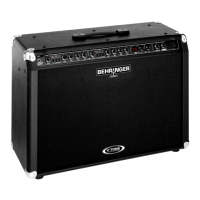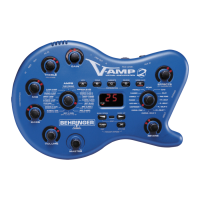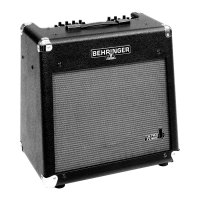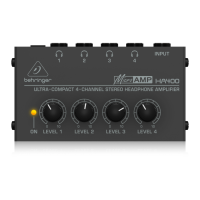EXPANDER 92, 93
Rev Time/
Delay Time²
Rev Mix/
Delay Mix²
Threshold
GUITAR
COMBO
94 - 99
Delay Time*/
Rev Time²
Delay Mix/
Rev Mix²
Drive
*) Tap tempo: MIDI Control No. 64
²) depends on Variation
Table 4.1: MIDI-controllable effect parameters
Channel switching: Changing modeling CHANNELS is done
via controller #10. If you send value 0 via this controller, then
channel 1 is active. Sending value 1 activates channel change to
channel 2. Program change instructions can also be used to
change channels. Program change #123 activates channels 1
and program change #124 activates channel 2 of your V-TONE.
In addition to switching channels, you can also deactivate the
effect. To this end, send value 0 via controller #11. Value 1
activates the effect again.
Sending program change #127 activates the tuner. As soon as
another program change number is sent, the tuner is automatically
deactivated.
You determine the input volume of the effect module by using
MIDI controller #7. This lets you adjust the volume of your
V-TONE to your own requirements. Since this controller does
not control master volume, you should first adjust the maximum
volume you need by using the master volume control, and then
use MIDI controller #7 to lower the volume. This function is also
called volume controller.
The operating range of the Wah effect is adjusted using MIDI
controller #27.
Furthermore, if youre using LFO-controlled modulation effects,
you can deactivate LFO and implement modulation via MIDI
controller #27. To activate this MIDI controller, you should first
set up the LFO velocity either directly on your V-TONE or set the
respective MIDI controller to value 0.
Of course, you can use a MIDI sequencer or a computer-based
MIDI editor for MIDI remote control, particularly in the home
recording environment.
5. TUNER
s The integrated tuner is activated by pressing the CHANNEL
key for about 2 seconds (directly on the amp or on the
footswitch).
5.1 Tuning your guitar
The chromatic tuner automatically recognizes the frequencies
of guitar notes. For A string, this means a frequency of 110 Hz.
When you connect your guitar to the V-TONE and strum a string,
the tuner tries to recognize the tone and shows it in the display.
Because the tuner functions chromatically, it can also recognize
semitones. These are shown in the display with a b
accompanying the value.
However, it may be the case that a played note (shown in the
display as for example a) slightly deviates from the ideal tone.
This will be indicated by lighting up at least one of the red tuner
LEDs (HIGH/LOW) near the FX display. The faster the LED blinks,
the harsher the deviation of the played tone from the note shown
in the display. If the middle LED (green) lights up, the tone you
played is completely in tune with the tone indicated in the display.
When the tuner is active, the loudspeaker outputs are typically
muted. However, sometimes it is preferable not to mute the signal
in order to let you have acoustic control of what you are doing
while you are tuning your guitar. For this reason, the V-TONE
has an integrated tuner level function.
s You can adjust tuner volume from 0 to 99 by using the FX
control. At 0 the guitar signal is completely muted. After a
successfully implemented adjustment, the display auto-
matically goes back to tuner mode.
5.2 Setting up the a reference tone
To put complete freedom at your disposal when tuning your
instrument, you have the option to change the preset of the
reference tone a. Here is a quick intro to the subject.
The so-called chamber tone a has been continually revised
upwards ever since it was first measured: tuning forks of Bach,
Handel or Mozart were at 415, 420 or 421 Hz (vibrations pro
second).
Nowadays, orchestras set the a with 444 Hz, and the Berlin
Philharmonic Orchestra wishes to stay ahead: their chamber
tone a lies at a full 447 Hz.
The reference tone a of the V-TONE is programmed at
440 Hz. Lets say, you want to work with a big orchestra that
works with the chamber tone a set to 444 Hz. To activate the
function that changes the chamber tone, do the following:
s Activate the tuner by keeping the CHANNEL key pressed
for a few seconds.

